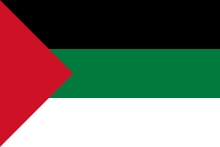This is an old revision of this page, as edited by 149.254.219.174 (talk) at 19:07, 31 May 2014. The present address (URL) is a permanent link to this revision, which may differ significantly from the current revision.
Revision as of 19:07, 31 May 2014 by 149.254.219.174 (talk)(diff) ← Previous revision | Latest revision (diff) | Newer revision → (diff)

The Pan-Arab colors are black, white, green and red. Individually, they have their origins in the flags of prominent empires and dynasties in Arab history. They were first combined in the flag of the Arab Revolt in 1916. They are used currently in the flags of Jordan, Kuwait, Palestine, Sahrawi Republic, Libya and the United Arab Emirates. A sub-set of the Pan-Arab colors are the Arab Liberation colors, in which green is less significant. These appear in the flags of Egypt, Iraq, Sudan, Syria, and Yemen, and formerly in the flags of the short-lived Arab unions of the United Arab Republic, the Arab Federation and the Federation of Arab Republics. Each of the four Pan-Arab colors were intended to represent a certain Arab dynasty, or era. The black was the color of the banner of Muhammad; white was used by the Umayyad Caliphate; green was used by the Fatimid Caliphate; and red was the flag held by the Khawarij.
Each of the four Pan-Arab colors were intended to represent a certain Arab dynasty, or era. The black was the color of the banner of Muhammad, and of the Abbasid Caliphate; white was used by the Umayyad Caliphate; green was used by the Fatimid Caliphate as a reminder of the Battle of Badr to symbolize their support of Ali Bin Abi Talib; red was the flag held by the Khawarij, and then became the symbol of rulers in the Maghreb, and Al-Andalus.
Other Arab states, while not using all of the Pan-Arab colors, do use some of them in other combinations. For example, the flag of Algeria uses green, white, and red, but not black.
Current flags with Pan-Arab colors
Sovereign states
Partially recognized states
Unrecognized territories
Former flags with the Pan-Arab colors
-

Egypt (1952–1958) -

Federation of Arab Republics (Egypt (1972–1984), Syria (1972–1980), and Libya (1972–1977)) -

Libya (1969–1972) -

Iraq (1921–1959) -

Arab Federation (1958) -

Iraq (1959–1963) -

Iraq (1963–1991) and Syria (1963–1972) -

Iraq (1991–2004) -
 Syria (1920-03-08 to 1920-07-24)
Syria (1920-03-08 to 1920-07-24) -

Syria (1932–1958 and 1961–1963) -

United Arab Republic (1958–1961) -

North Yemen (1962–1990) -

South Yemen (1967–1990) -
 Arab Islamic Republic (1974)
Arab Islamic Republic (1974)
-
 Hejaz (1917–1920)
Hejaz (1917–1920)
-
 Hejaz (1920–1926)
Hejaz (1920–1926)
-
 Hejaz (1926–1932)
Hejaz (1926–1932)
Former Arab flags
-

Rashidun Caliphate
(632–661) -

Umayyads
(661–750) -

Abbasids
(750–1258) -

Fatimids
(909–1171) -

Ayyubids
(1171–1341) -

Mamluk Sultanate
(1250–1517)
See also
References
- ^ Pan-Arab Colours, crwflags.com
- Abū Khaldūn Sati' al-Husri, The days of Maysalūn: A Page from the Modern History of the Arabs, Sidney Glauser Trans., (Washington D.C.: Middle East Institute, 1966), 46.
- Mahdi Abdul-Hadi, Palestine Facts: The Meaning of the Flag, passia.org
- Abū Khaldūn Sati' al-Husri, The days of Maysalūn: A Page from the Modern History of the Arabs, Sidney Glauser Trans., (Washington D.C.: Middle East Institute, 1966), 46.
- Mahdi Abdul-Hadi, Palestine Facts: The Meaning of the Flag, passia.org
External links
- Pan-Arab colors
- Evolution of the Arab Flag, by Dr. Mahdi Abdul-Hadi (in Arabic)









